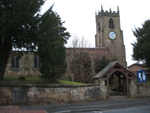The first recorded mention of Chellaston was in 1009 when it was known
as Ceoleardesbeorge (beorg meaning hill) [Place Names of Derbyshire
by Cameron.] By 1086, the Domesday Survey named it as Celerdestune
or Celardestune . Eventually, after various spellings through time
it became known as Chellaston.
Population
The population of Chellaston at the time of Bishop Crompton’s
religious census in 1676 was about 140. In 1789 Pilkington described
Chellaston as “a small farming village of 42 houses”.
The national census of 1801 gave a population of 205 and in 1901 the
population was 654, so in the 100 intervening years the population
had increased more than threefold. The population had increased to
15,768 as per the 2021 census). It is difficult to keep track of the
current population with the new housing in and around the original
village.
Religion
St Peter’s Church dates from at least the 13th century when
mention of “a gift by Alexander
formerly Bishop of Coventry and Lichfield to Walter, Bishop of Karliol
[Carlisle] of the church of Meleburn with its chapels of Chelardeston
and Neuton” is made of it in a document in the Cumbrian County
Record Office. Alexander
formerly Bishop of Coventry and Lichfield to Walter, Bishop of Karliol
[Carlisle] of the church of Meleburn with its chapels of Chelardeston
and Neuton” is made of it in a document in the Cumbrian County
Record Office.
The responsibility for the church at Chellaston stayed with Melbourne
until the late 19th century when the Reverend Joseph Hughes became
the first resident incumbent at St Peter’s, Chellaston, previously
a curate had looked after the church. In 1840 a tower was built on
the church.
Today St Peter’s Church is a lively and friendly community church
in the Diocese of Derby and is always ready to welcome new people.
St
Peter’s Church Methodism
Methodism came to Chellaston in about 1812 when a Mr W. Astle asked
that his house, situated in Chellaston, may be used for public worship
by those dissenting from the Church of England.


Chapel in Chapel Lane – built in 1816 High
Street – built in 1876
In 1816 a chapel was built in Chapel Lane. This is now a private
house. The 1816 building was used until 1876, when a new chapel
was built in the High Street. Worship takes place there each Sunday.
Unfortunately this church on High Street closed in September 2025.
It remains to be seen what happens to the building now.
Baptists
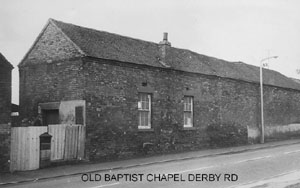
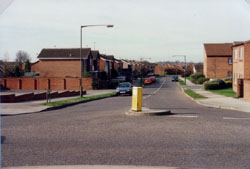
The Baptist Chapel and the same location in the late 20th century
(Derby Road/Parkway junction)
In 1868 Chellaston Baptist Chapel was opened on Derby Road but this
disappeared with the building of the Parkway estate in the late
1970s.
Catholics
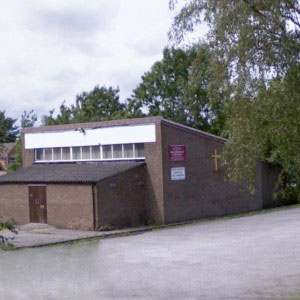 After
worshipping at the Chellaston Golden Hour club on Maple Drive the
opportunity came for the Catholics to open their own Chapel of Ease
in the village. In 1971 the St. Ralph Sherwin Roman Catholic Centre
on Swarkestone Road opened. This closed in January 2019 and has
now been demolished to make way for a supermarket. After
worshipping at the Chellaston Golden Hour club on Maple Drive the
opportunity came for the Catholics to open their own Chapel of Ease
in the village. In 1971 the St. Ralph Sherwin Roman Catholic Centre
on Swarkestone Road opened. This closed in January 2019 and has
now been demolished to make way for a supermarket.
St Ralph Sherwin Catholic Church
Alabaster
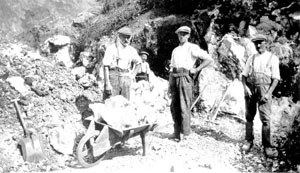 During
the medieval period Chellaston became known worldwide for the quality
of the alabaster mined in the area to produce monuments, tombs and
tablets for churches etc. During
the medieval period Chellaston became known worldwide for the quality
of the alabaster mined in the area to produce monuments, tombs and
tablets for churches etc.
The mines were mainly in the area between Chellaston and the neighbouring
village of Aston on Trent and they ceased producing alabaster in
the early 20th century.
Workers
at an Alabaster Mine in the area
Education
Following the 1870 Education Act the Board School was opened in
1878 in School Lane, the building is still part of the Infants school
today.
Children attended this school for the whole of their school life.
Eventually, in 1967, a junior school was built on the Flatts and
in 1977 Chellaston Senior School (now Chellaston Academy) was opened.

Another primary school (Homefields) was opened on Parkway in 2001.
A further primary school, Chellaston Fields Spencer Academy opened
on Riber Drive in September 2019.
School
photograph - 1941
Hotels / Public Houses
There are, at the moment (October 2025), five public houses / bars
in Chellaston. The New Pin (formerly the Corner Pin), R&R's
Sports Bar, Hickory’s Smokehouse (formerly the Bonnie Prince),
The Lawns (a hotel with accommodation.) and the popular Crossbar,
a sports bar on Chellaston Park, Snelsmoor Lane.
There have been 2 closures in the past 20+ years;
the Rose and Crown and The Red Lion.
The Corner Pin is partly an 19th century building,
although it is attached to an earlier cruck building which has been
integrated into the main structure. It was originally called the
New Inn, and is now thankfully restored. It re-opened, as the New
Pin, in October 2025.
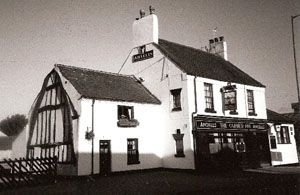
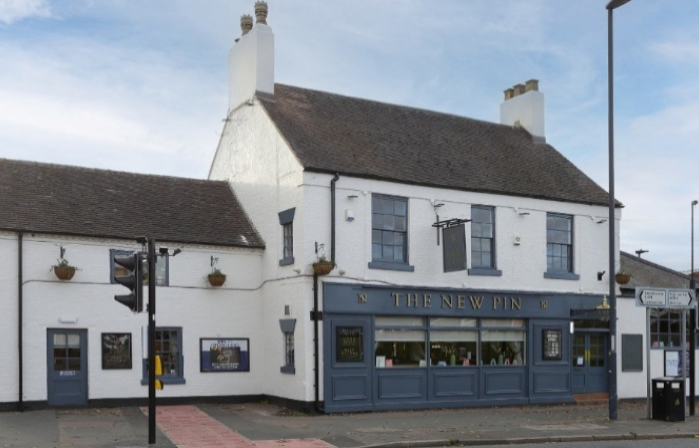
Corner Pin (c2010)
New Pin (October 2025)
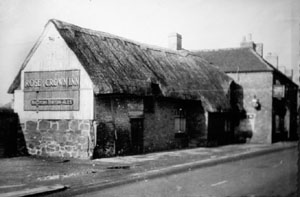
The Rose and Crown was almost certainly the oldest Chellaston public
house. It was originally thatched and although much altered if you
looked closely, at the 1950s photograph, it was a far older building.
This building was subject to a planning application to demolish
it and replace with a supermarket which was granted in 2018. It
closed in January 2019 and has now been demolished to make way for
Lidl’s supermarket car park.
The
Rose and Crown in the 1950s
The Lawns was converted from a Victorian villa (The Lawn) into a
hotel/public house (The Lawns) in the mid to late 1900s.


The
Lawn as a Victorian Villa The
Lawns - 2016
In March 2010, after a closure of approximately a year, The Lawns
re-opened under new management and now has a restaurant area, and
two bar areas with television in which food can be served. There
is also a function room which caters for weddings etc. Overnight
accommodation can be found here.

Hickory’s Smokehouse, (formerly the Bonnie Prince) was converted
in the late 1990s from a Victorian residence (Holme Leigh) Meals
are served here.
Bonnie Prince - 2011 (now, 2025, Hickory’s Smokehouse)

There is also the popular R & R Sports Bar and Lounge, with
a bar downstairs and lounge-style room upstairs. This was previously
the Chellaston Club, and before that a Royal British Legion social
club.
This building was also a Victorian villa called The Hollies. The
occupant in 1911 was Henry Fowler (later Sir Henry Fowler), Chief
Mechanical Engineer of the Midland Railway.
Chellaston Club - 2011

Another public house was the Red Lion which originally dated from
c1829. This was demolished in August 1963 and a new pub built on
the site of the gardens.
This public house closed in the 2000s and remained empty for a
couple of years. It was eventually converted into a Tesco supermarket.
The Two Red Lions
before demolition of the original one
Canal
 In 1796 the
Derby Canal opened, running through west Chellaston linking the
Trent and Mersey Canal with Derby. The canal closed in the mid 20th
century but there are now plans to re-open it. In 1796 the
Derby Canal opened, running through west Chellaston linking the
Trent and Mersey Canal with Derby. The canal closed in the mid 20th
century but there are now plans to re-open it.
Canal
at Shelton Lock in the 1950s
Turnpike
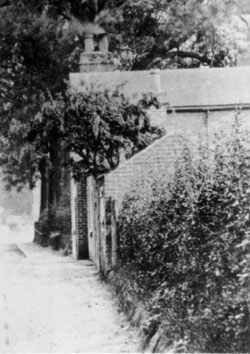 The road through
Chellaston became a turnpike (toll road) in 1856. The toll house
stood at the roadside, approximately where the bus stop in front
of the chemist’s shop is now. The road through
Chellaston became a turnpike (toll road) in 1856. The toll house
stood at the roadside, approximately where the bus stop in front
of the chemist’s shop is now.
Chellaston
Toll House
Railway
 The Midland Railway opened the Derby-Melbourne branch in 1868, eventually
extending to Worthington, Weston on Trent and Stenson.
The Midland Railway opened the Derby-Melbourne branch in 1868, eventually
extending to Worthington, Weston on Trent and Stenson.
There was a railway station at the bottom of Station Road which
closed in 1930 and after that the branch line operated solely as
a freight line, eventually this ceased about 1966.
Chellaston
and Swarkestone Station
Today Chellaston is a rapidly expanding suburban village within
the City of Derby.
|



